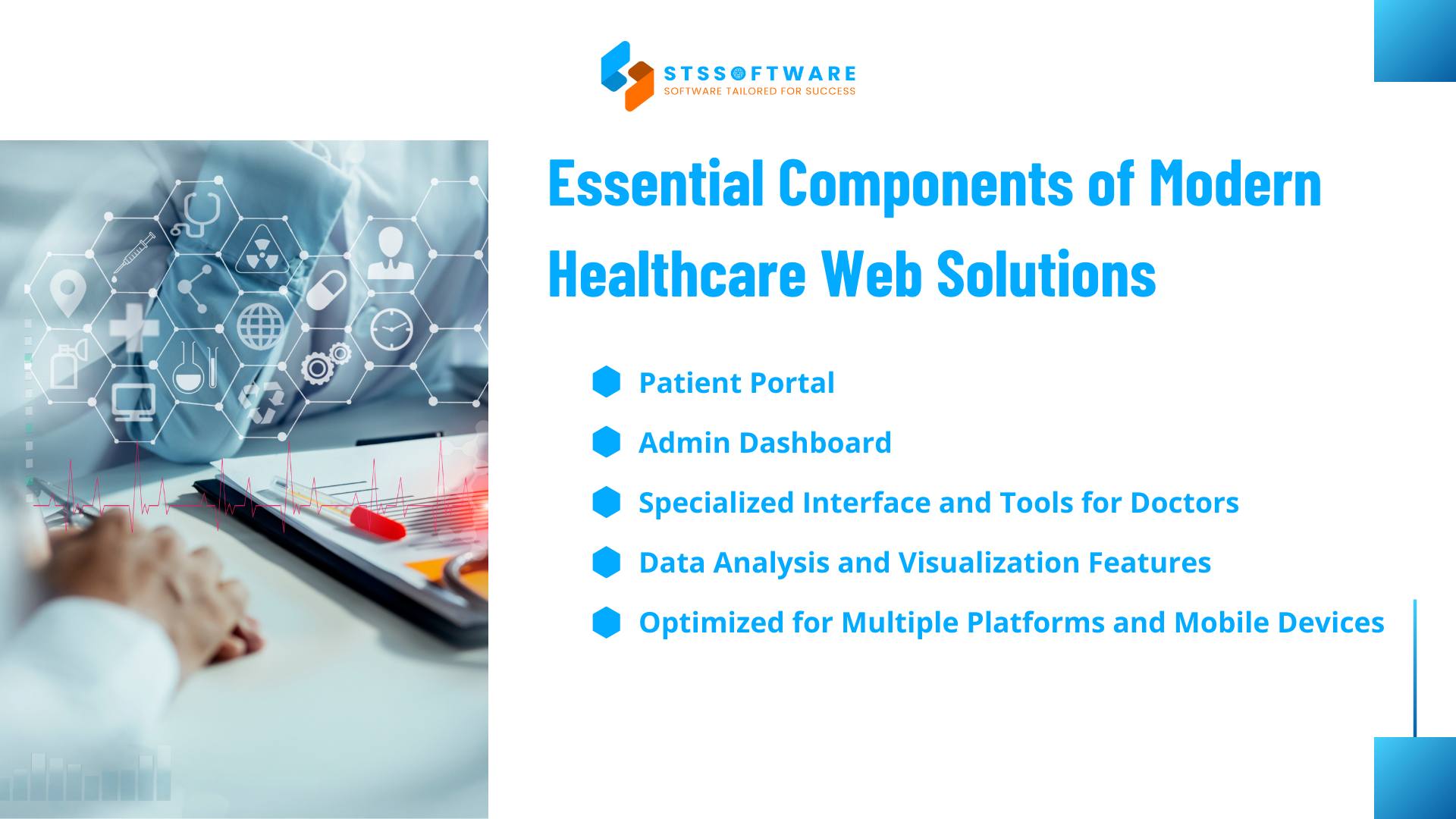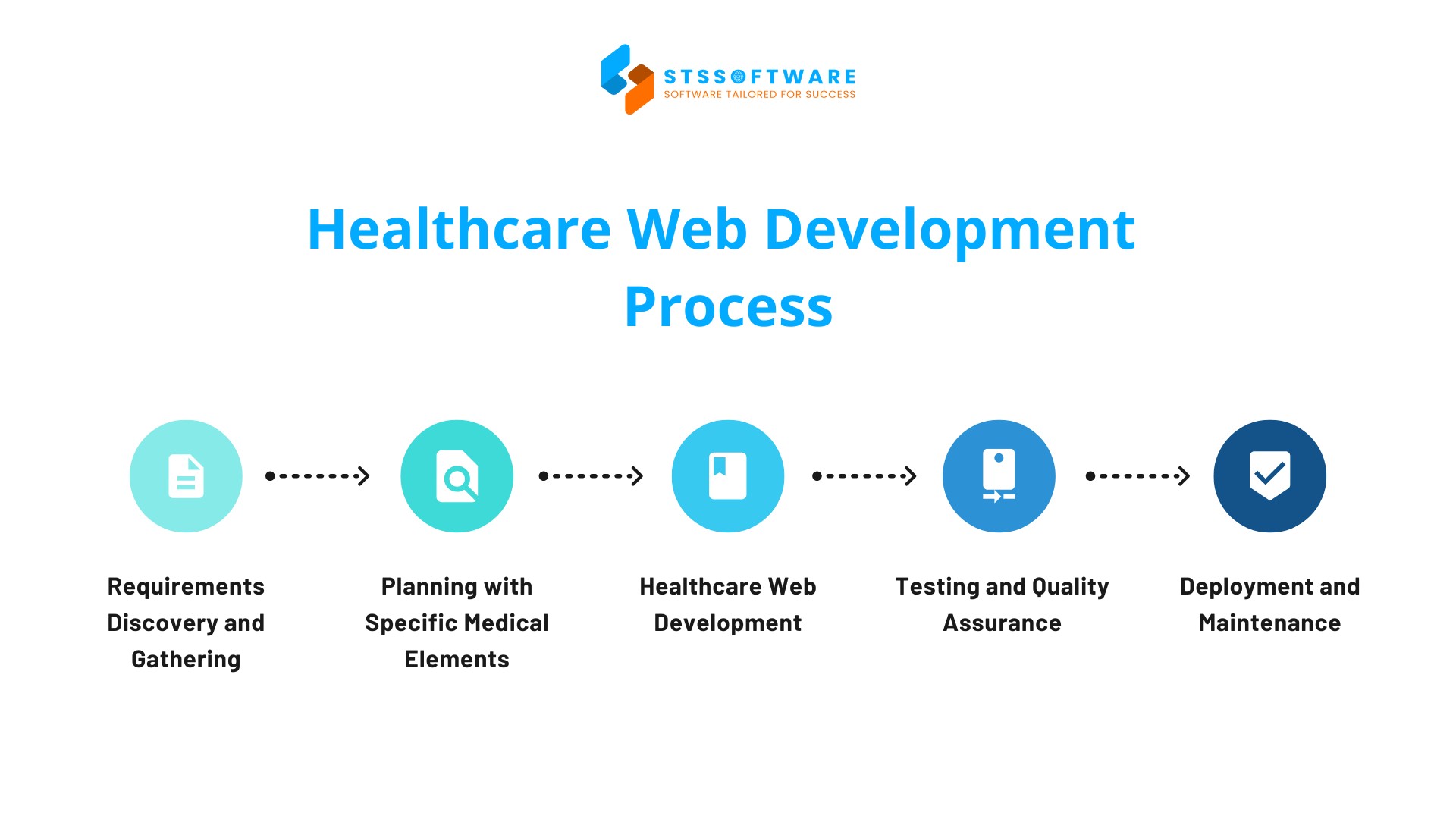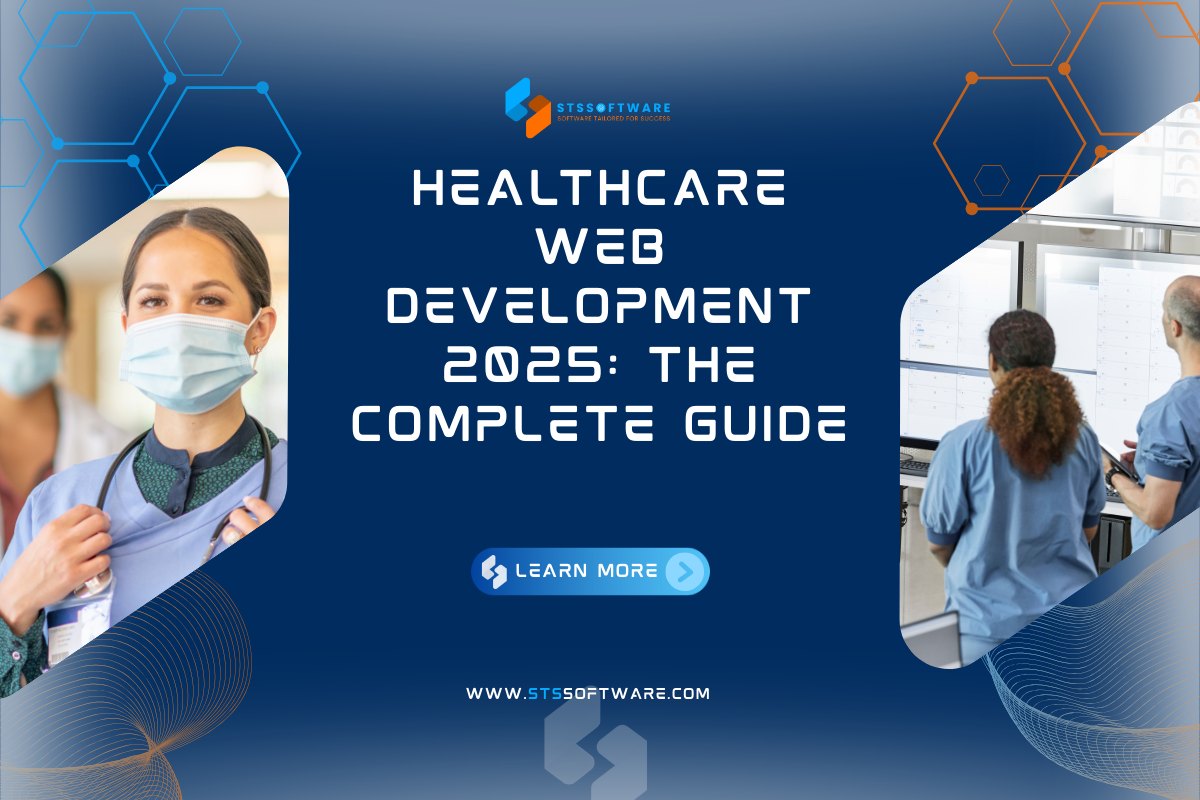In recent years, healthcare web development helps improve patient care and streamline operations. Today’s healthcare website solutions strongly developed into integrated systems, including EMR, telemedicine, online registration, and appointment tools. By 2023, the global medical web application market reached approximately USD 1.5 billion and is projected to hit USD 4.8 billion by 2032, with a strong CAGR of 13.8%.
Entering 2025, the healthcare website development industry is expected to witness revolutionary changes. AI technology, Big Data, personal data security (HIPAA/GDPR) and security needs push healthcare units to upgrade their websites. New generation healthcare websites need to meet strict standards for security, fast, and easy to integrate.
With increasing demands, choosing a partner with deep expertise in healthcare web development becomes extremely important. Healthcare web development requires not only general programming skills but also a deep understanding of legal regulations, user behavior, and how to optimize the online patient experience.
In this article, we will learn about prominent trends, core technologies, and important notes for an effective healthcare website project.
Key Healthcare Web Development Trends for 2025
Amid the digital explosion, digital trends are reshaping the way patients interact with healthcare websites.
Integrating Artificial Intelligence (AI) and Machine Learning
One of the first highlights is the integration of AI and machine learning into online healthcare systems. These technologies help personalize care, aids early diagnosis, and boosts efficiency of healthcare web application development. New AI techniques create personalized treatments using the electronic medical record data.
Remote Patient Monitoring
With intensified focus on remote patient monitoring (RPM) capability, these new medical web applications will integrate smart wearables for continuously recording health indicators. These indicators are heart rate, blood pressure, and blood sugar, providing central oversight for intervening doctors when necessary.. This use will also help tremendously alleviate the burden on health systems amid an accelerated aging population.
Expanding Remote Healthcare Services (Telehealth)
Telehealth is another trend witnessing a surge way beyond just video consultations to diagnostic and treatment services. The healthcare web development platform thus must provide for the transferring of high-resolution medical images, utmost confidentiality of the patient information, and seamless appointment scheduling and payment facility.
Applying Blockchain Technology to Healthcare Data Security
Blockchain technology is being considered the future key to achieving healthcare data protection. This is a secure means of processing records and transactions in the digital healthcare ecosystem due to its transparency and immutability.
Voice Interface (VUI) and Accessibility Solutions for People with Disabilities
Last but not least, VUI and accessibility features are now essential in healthcare web application development. Voice tools help users book visits and hear test results, improving patient experience and equal health access.
Therefore, healthcare units must plan a clear web strategy. They should choose technology partner with extensive expertise in healthcare web development.
Essential Components of Modern Healthcare Web Solutions

To meet the growing demand in the healthcare sector, healthcare web application development requires many features. These include patient portals and internal systems.
Patient Portal
First of all, the patient portal is an indispensable component of any healthcare web app development system. Patients can view records, book appointments, and chat with doctors via the portal. A good portal not only encourages self-care but also reduces team responsibilities.
Admin Dashboard
Along with that are dashboards for administrators – where features that support monitoring the operations of the medical facility are concentrated. These dashboards help manage appointment schedules, assign personnel, monitor financial status, and report on overall performance. As a result, decision-making is quick and based on real data.
Specialized Interface and Tools for Doctors
Doctors need tools for record access, live updates, and managing prescriptions. These tools help them work more efficiently. The interface design must be minimalistic but fully functional, helping doctors operate quickly and accurately in high-pressure working environments.
Data Analysis and Visualization Features
In addition, the ability to visualize data and analyze is also an increasingly important factor. Dashboards show charts and data, helping detect trends and guide treatment. Integrating advanced analysis tools will provide a more comprehensive view of the performance of the entire system.
Optimized for Multiple Platforms and Mobile Devices
Finally, it is impossible not to mention cross-platform compatibility and optimization on mobile devices. More users use mobile devices. So, healthcare web app development must work well across different devices.
Overall, these features build strong the medical web platforms. They also improve service quality, improving patient experience and help staff work better.
Technical Frameworks and Technologies for Healthcare Web Development
In the healthcare web development field, choosing the right platform protects systems and ensures smooth performance under load. The healthcare web developer should put a great deal of thought into everything from the front end, through the back end, to the database and cloud infrastructure.
Frontend Framework For Medical Website
Frontend frameworks such as React.js, Angular, or Vue.js offer flexible and secure interfaces. They also ensure a smooth user experience. For example, building a patient dashboard with React helps optimize loading speed and real-time interaction.
Backend Technologies for Healthcare Applications
On the backend, technologies like Node.js, Ruby on Rails, or Django (Python) are often chosen for medical application development. These frameworks scale easily and protect sensitive medical data. For example, Django has built-in security. It helps meet strict laws like HIPAA in the US.
Database Solutions for Healthcare Web
Database solutions also need special attention. Systems such as PostgreSQL or MongoDB store large data securely. They also allow flexible access control. In healthcare web app development projects, choosing a database that is scalable and secure according to industry standards is a prerequisite.
API Integration Strategy for Healthcare Systems
Integrating other healthcare systems with API integration is an indelible part. Integration with widely used EHR (Electronic Health Records) systems like Epic, Cerner or health insurance businesses implies a fair strategy for API usage. Thus, it keeps data secure and synchronized. A technical challenge on which a healthcare web developer needs to work with finesse.
Building Cloud Infrastructure for Healthcare Applications
Lastly, as far as cloud infrastructure is concerned, whether it is AWS, Microsoft Azure, or Google Cloud all provide instruments specially geared towards the health care industry-from-looking after its big data management to security and regulatory compliance. For example, AWS provides HIPAA-certified services, and this, to some extent, reduces the regulatory burden on healthcare organizations.
Compliance and Security in Healthcare Web Development
In fact, ensuring regulatory compliance and implementing strict security measures during healthcare web development serve not just as technical prerequisites, but also great parameters of trust with end users. In particular, healthcare web application development platforms handling sensitive medical data must necessarily obey very stringent privacy-information protection requirements.
HIPAA Compliance in Healthcare Web Development
Healthcare web applications in the U.S. must comply with HIPAA regulations to meet legal requirements. HIPAA requires that the system ensure maximum protection of patient data integrity through measures such as encryption, access control, and secure storage. For example, an EHR system deployed in a hospital must guarantee that all the data being transmitted between the application and the server is encrypted according to the HIPAA standard with SSL/TLS.
Read more: HIPAA Compliant App Development: Comprehensive Guide 2025
Security Measures in Healthcare Web Development
In terms of security, protocols and best practices need to be applied consistently. Data protection must start with encryption of data at rest and data in transit, combined with regular penetration testing to detect potential security vulnerabilities. In addition to these, segmentation of networks and WAF is security techniques being applied more and more.
User Authentication and Authorization in Healthcare Web
For the sake of maintaining secure user accounts, 2FA or MFA should be used to authenticate and authorize all instances of the systems. Role-based authorization (RBAC) works to limit the risk of breach of access to the sensitive medical documents.
Building a Tracking and Auditing System (Audit Trails) in Medical Web
Another important factor in healthcare web application development is building a comprehensive audit trail solution. Audit trails allow detailed recording of all actions related to patient data — from access, editing to deletion. This is an important basis for reviewing, early detection of unusual behavior or serving investigations when there is a security incident.
For example, a clinic management platform in the US requires all patient data access to be retained for a minimum of 6 years to meet HIPAA regulations.
In short, when developing any web application in the healthcare sector, businesses and developers not only need to be technically savvy but also need to constantly update legal requirements and apply the highest level of security standards to ensure user safety and the reputation of the organization.
User Experience Design for Healthcare Applications
In the healthcare web app development field, user experience (UX) design must not only be aesthetically pleasing but also must be consistent with the sensitive and specific nature of medical data. Good applications allow easy and fast access to information by patients and their efficient working with medical personnel.
Accessibility for All Patient Groups
The first component that has been considered is accessibility for all patient groups such as the elderly, people with disabilities, or those whom it may be difficult to use electronic devices. For example, several platforms for developing healthcare websites now conform to WCAG 2.1 standards, supporting screen readers for the visually impaired or adding options to increase font size and high contrast for the elderly.
Simplifying Interfaces for Complex Medical Data
Then designing a simple interface to express complex medical data is the daunting task. A good design of dashboards relaying information on patients’ health such as test results or therapy goes into it. The typical is in the management of electronic health records (EHR) in hospitals across the breadth of the U.S.; blood test charts are converted to starkly colored contraction-bar diagrams, enabling viewing by doctors and patients within seconds and with pretty good retention in easily absorbing the changes in health in a matter of seconds.
Mapping the Patient Journey
Drawing patient journey maps is also important in optimizing the experience. A typical journey from registering for a medical examination, checking appointments, receiving test results to monitoring treatment progress needs to be carefully analyzed. During the development of a healthcare web application, several clinics set an automatic appointment reminder procedure by SMS or email so that the patient would not forget important milestones.
In-depth UX Research Methods
To inform the design about actual needs, various healthcare-related UX research methods such as in-depth patient interviews, clinical usability testing, or heatmap analysis are often employed. These techniques help the development team understand the behaviors, challenges, and expectations of specific user groups.
Building a Design System for Healthcare Applications
Finally, building a design system specifically for healthcare applications is key. A good design system will standardize all interface elements — from colors, typography, to the way medical information is presented — to ensure consistency, scalability, and maintainability. For example, many healthcare website development platforms are now building separate UI kits, with color rules that are friendly to the eyes, and emphasizing urgent health warnings.
Healthcare Web Development Process

The healthcare web development process requires a much higher level of standardization and compliance than other fields, due to the sensitive data involved and strict security regulations. This whole process step by step creates a standardized product to help patients, doctors, and health organizations.
Requirements Discovery and Gathering
The first step is Discovery and Requirements Gathering. In this phase, the healthcare web developer needs to interact with all stakeholders including hospitals, clinics, and doctors and patients to rightly capture their needs, view their business goals, and determine the legal constraints that must be complied with. For example, a cardiology clinic may require a system to manage appointments, store ECG data, and remind patients about their future checkups.
Planning with Specific Medical Elements
Next is planning with specific medical factors. Unlike regular web projects, planning in healthcare requires anticipating issues such as patient data access, multi-layer authentication, and integration with existing hospital management systems (HIS). Some solutions also have to consider compliance with HIPAA (US), GDPR (Europe) or the Law on Personal Information Security in Vietnam.
Healthcare Web Development
In terms of development methods, healthcare web developers often prioritize flexible models such as Agile or Scrum. This approach allows for continuous updates of real-world feedback from medical staff during the implementation process, helping the application adjust promptly, avoiding wasting resources. Some large projects also apply the DevOps model to automate testing and deploy faster.
Testing and Quality Assurance in Healthcare Web Development
Testing and Quality Assurance in the field of healthcare web development is especially important. In addition to functional checks, the process involves testing for security, performance, and disaster recovery.
For example, an online appointment system needs to be tested for high load during peak hours on Monday mornings.
Healthcare Web Deployment and Maintenance
Once complete, the Deployment and Maintenance phase requires adherence to best practices. Deployment needs to be secure, server optimization, regular backup configuration, and a process for software updates and security patches. The healthcare web developer team must also be available to provide technical support to resolve any issues that arise, while ensuring the system operates stably and complies with the law throughout the product lifecycle.
Case Studies: Successful Healthcare Web Development Projects
In the field of healthcare web development, successful projects demonstrate not only technical competence but also the ability to understand the specific requirements of the healthcare industry. Below are some typical case studies, clearly showing the importance of developing specialized web solutions.
Hospital website transformation – Mayo Clinic
A typical example of success in the field of healthcare website development is the website restructuring project of Mayo Clinic. With the goal of improving the patient experience and easy access to information, Mayo Clinic redesigned the entire interface, optimized the ability to search for services and integrated medical content according to modern UX standards. The new website not only provides reliable medical information but also supports users to quickly book appointments.
Patient portal development – MyChart by Epic Systems
In the field of healthcare web application development, MyChart is a prominent example. This application allows patients to access their medical records, schedule appointments, and see their test results in addition to providing a secure method for communicating with their doctors. Mainly adopted in most hospitals and clinics across the United States, this application has changed the face of interaction between patients and the healthcare system.
Building a telehealth platform – Amwell
When it comes to the development of remote healthcare platforms in healthcare web development, Amwell is a typical example. This is a telehealth platform that supports online video consultations between patients and doctors, and integrates with many large EMR systems. With a friendly interface and high scalability, Amwell has become a strategic partner of many large hospitals such as Cleveland Clinic.
Healthcare administration tool – CureMD
CureMD is another successful example in the healthcare web application development sector, with a set of administrative management tools and electronic health records (EHR). It also features a highly easy-to-use dashboard to manage appointments, invoices, and medication that also integrates patient communication. CureMD helps healthcare organizations in thousands to increase operational productivity while optimizing patient management.
The above projects show that with a thorough approach, industry knowledge, and appropriate technology application, healthcare web development products not only meet business needs but also bring sustainable value to both patients and healthcare organizations. The success of these case studies also demonstrates the key role of choosing a reputable and experienced healthcare website development partner.
Why Choose STS Software as Your Partner for Healthcare Web Development
In the context of the increasing demand for digitalization in the healthcare sector, finding a partner with extensive expertise in healthcare web development plays a key role. STS Software is proud to be the top choice thanks to its solid foundation of expertise and practical experience.
Specialized Experience in the Healthcare Industry
First of all, we have extensive experience in the healthcare industry. The team of experts at STS Software has participated in developing many healthcare web app development solutions, from patient portals, online appointment booking systems, to hospital management support platforms. With our deep understanding of the medical examination and treatment process and the particular need of the healthcare industry, we craft products that are practically doable.
Technical Knowledge and Healthcare Industry Standards
On a technical note, the knowledge of STS software in modern web technologies is paralleled only by its second specific knowledge of healthcare technical standards such as HL7, FHIR, or EMR/EHR system integration. In this way, we can design and develop healthcare web development solutions that at once offer a strong performance while being designed and developed to synchronize with the preexisting healthcare ecosystem.
Regulatory Compliance Development Methodology
We place great importance on the compliance-first approach throughout the entire development process. STS Software is committed to building products that strictly comply with regulations such as HIPAA (in the US), GDPR (in Europe) and other international healthcare security standards. By implementing end-to-end data encryption, multi-layer authentication and granular access control, we ensure that every application protects the safety of users’ health information.
Customer-Focused Development Methodology
Our development approach is always customer-centric. STS Software prioritizes listening, responding and accompanying customers at every stage, from requirements analysis, design, development to deployment and operation. Each healthcare web app development solution we provide is “tailored” for the specific goals of each healthcare organization.
Long-term Support and Maintenance Commitment
Finally, STS Software is committed to long-term companionship with customers with continuous technical support and maintenance services. We update systems, fix bugs, and boost performance regularly. This keeps the product stable and future-ready.
STS Software is confident that it is a healthcare web developer development partner that you can trust to accompany you on your journey to digital healthcare.
Conclusion and Next Steps
There is no denying that the future of healthcare web development is opening up many breakthrough opportunities. AI, big data, and cloud make healthcare more personal, secure, and effective. And, thus, development of healthcare website development platforms will also support smooth record access and remote care. Both patients and doctors benefit from this.
Before starting a healthcare web development project, define your specific goals clearly. Are you aiming to build a patient portal, develop an appointment scheduling system, or launch a telehealth platform? Detailed planning from discovery onwards will save your project both time and money and eliminate risks in the future. Also, remember to look for a building partner which has a deep knowledge of the industry of healthcare website development to guide you from step one.
To enhance your understanding before implementing, in-depth literature may be accessed on the trends in health technology, health data security standards (such as HIPAA and GDPR), and successful case studies in this area, which share useful insights and help with defining a more practical strategy for development.
If you’re ready for digital healthcare, now is the perfect time to begin! And, do not forget to reach out to our experts to assist you in realizing your perspective!



